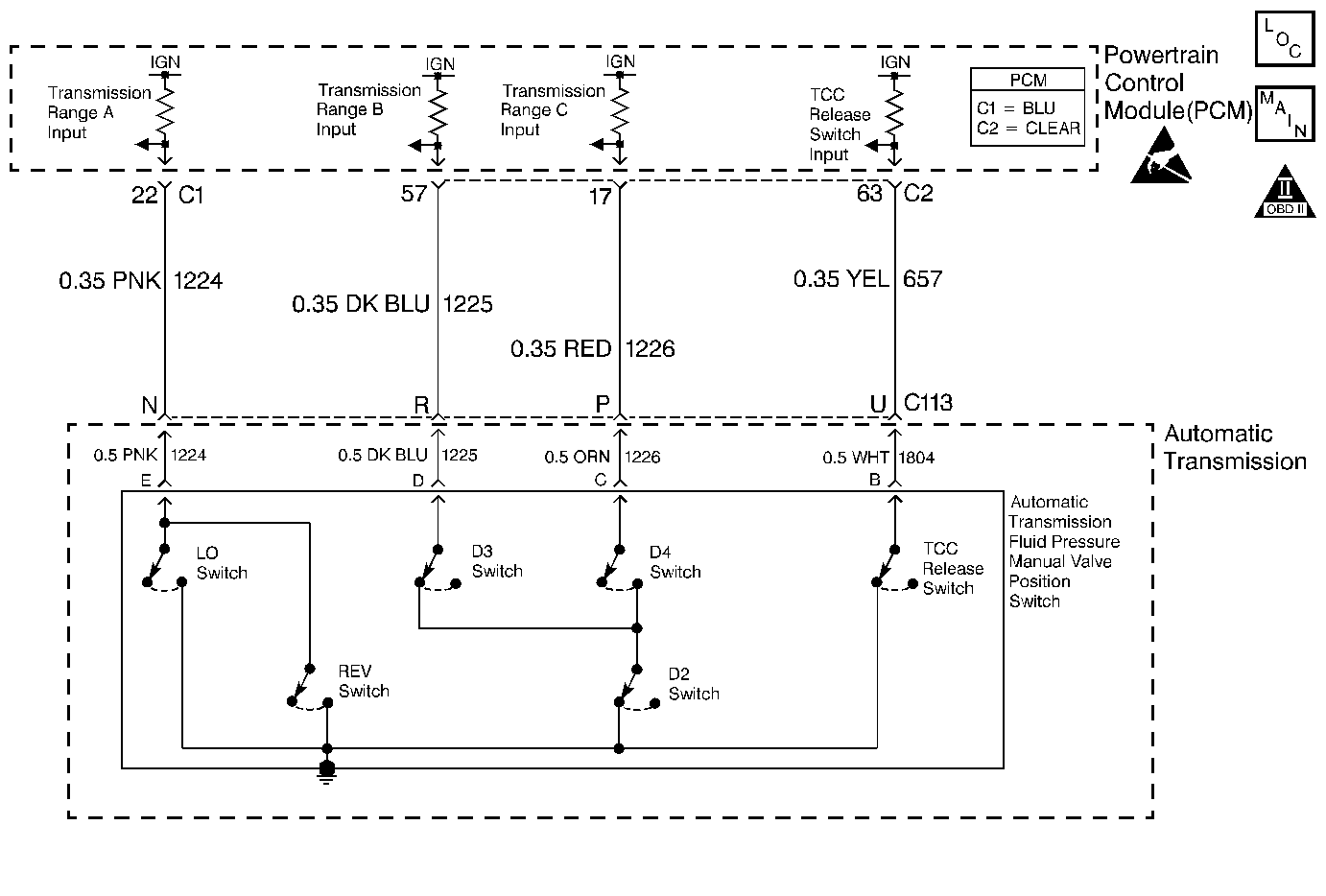
Circuit Description
The TCC release switch is part of the automatic transmission fluid pressure (TFP) manual valve position switch. The TFP manual valve position switch is mounted to the transmission valve body. The TCC release switch is normally-closed.
The switch signals the PCM that the TCC is released. This is accomplished by torque converter release fluid pressure acting on the switch contact which opens circuit 657/1804. When the voltage is high on the circuit, the PCM recognizes that the TCC is no longer engaged.
If the PCM determines that the TCC release switch is open (indicating that the TCC is not applied) and the TCC slip speed indicates that the TCC is applied, then DTC P1887 sets. DTC P1887 is a type D DTC.
Conditions for Running the DTC
| • | No A/T ISS sensor DTCs P0716 or P0717 are set. |
| • | No TCC PWM solenoid valve DTCs P0741 or P0742 are set. |
| • | No TFP manual valve position switch DTC P1810 is set. |
| • | The engine speed is greater than 500 RPM for 5 seconds and not in fuel shut off. |
| • | The transmission range switch is in D4. |
| • | The TCC is commanded ON. |
| • | The TCC pressure is 138-827 kPa (20-120 psi). |
| • | The TCC slip speed is -20 to +40 RPM. |
| • | The engine torque is 45-407 N·m (33-300 lb ft). |
Conditions for Setting the DTC
DTC P1887 sets when the following condition occurs twice in a single trip:
The TCC release pressure switch is open (indicating release pressure present) for 6 seconds.
Action Taken When the DTC Sets
| • | The PCM does not illuminate the malfunction indicator lamp (MIL). |
| • | The PCM inhibits TCC. |
| • | The PCM inhibits 4th gear if the transmission is in Hot Mode. |
| • | The PCM freezes shift adapts. |
| • | The PCM stores DTC P1887 in PCM history. |
Conditions for Clearing the DTC
| • | A scan tool clears the DTC from the PCM history. |
| • | The PCM clears the DTC from the PCM history if the vehicle completes 40 consecutive warm-up cycles without a diagnostic fault occurring. |
| • | The PCM cancels the DTC default actions when the fault no longer exists and the ignition switch is OFF long enough in order to power down the PCM. |
Diagnostic Aids
| • | Inspect the wiring at the PCM, the transmission 20-way connector and all other circuit connecting points for the following conditions: |
| - | A backed out terminal |
| - | A damaged terminal |
| - | Reduced terminal tension |
| - | A chafed wire |
| - | A broken wire inside the insulation |
| - | Moisture intrusion |
| - | Corrosion |
| • | When diagnosing for an intermittent short or open, massage the wiring harness while watching the test equipment for a change. |
Test Description
The numbers below refer to the step numbers on the diagnostic table.
-
This step tests the PCMs ability to recognize a grounded circuit.
-
Because of the harsh conditions inside the transmission, repairing the automatic transmission (A/T) wiring harness assembly is not acceptable. It must be replaced if it is damaged in any way.
Step | Action | Value(s) | Yes | No |
|---|---|---|---|---|
1 | Was the Powertrain On-Board Diagnostic (OBD) System Check performed? | -- | Go to Powertrain On Board Diagnostic (OBD) System Check in Engine Controls | |
2 |
Important: Before clearing the DTCs, use the Scan Tool in order to record the Freeze Frame and Failure Records for reference. Using the Clear Info function will erase the stored Freeze Frame and Failure Records from the PCM. Is TCC release pressure present? | -- | Go to Diagnostic Aids | |
Important: Additional DTCs will set. Refer to Automatic Transmission Inline Harness Connector End View . Is TCC release pressure present? | -- | |||
4 | Inspect circuit 657 (YEL) of the engine wiring harness for an open. Refer to General Electrical Diagnosis in Wiring Systems. Was a condition found? | -- | ||
5 | Inspect PCM connector C1 for bent, damaged or backed out connector pins. Was a condition found? | -- | ||
6 | Inspect circuit 1804 (WHT) of the automatic transmission wiring harness assembly for an open. Refer to General Electrical Diagnosis in Wiring Systems. Was a condition found? | -- | ||
7 | Repair the circuit as necessary. Refer to Wiring Repairs in Wiring Systems. Is the repair complete? | -- | -- | |
8 | Repair the connector pins as necessary. Refer to Wiring Repairs in Wiring Systems. Is the repair complete? | -- | -- | |
Replace the automatic transmission wiring harness assembly. Refer to Solenoids and Wiring Harness Replacement . Is the replacement complete? | -- | -- | ||
10 | Replace the automatic transmission fluid pressure manual valve position switch. Refer to Transmission Fluid Pressure Manual Valve Position Switch Replacement . Is the replacement complete? | -- | -- | |
11 | Replace the PCM. Refer to Powertrain Control Module Replacement/Programming in Engine Controls. Is the replacement complete? | -- | -- | |
12 | Perform the following procedure in order to verify the repair:
Has the test run and passed? | -- | System OK |
